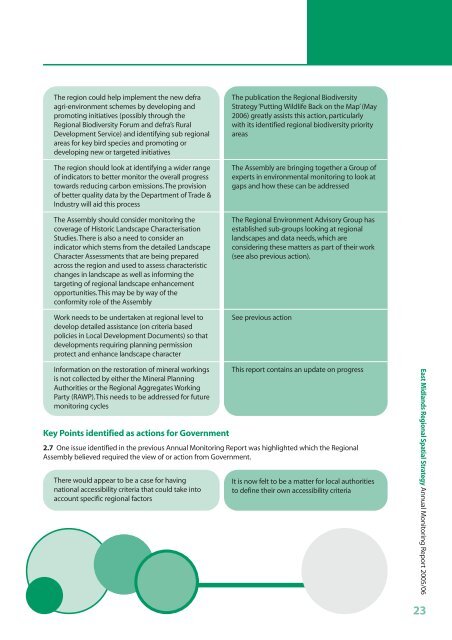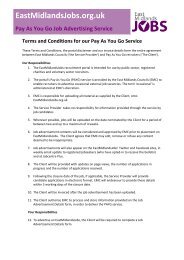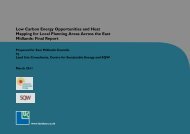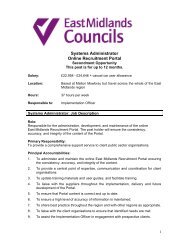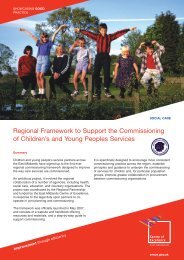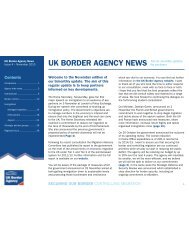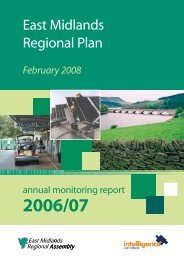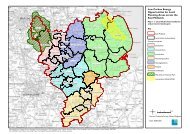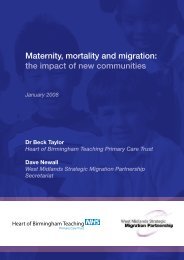East Midlands Regional Spatial Strategy 2005/06
East Midlands Regional Spatial Strategy 2005/06
East Midlands Regional Spatial Strategy 2005/06
You also want an ePaper? Increase the reach of your titles
YUMPU automatically turns print PDFs into web optimized ePapers that Google loves.
The region could help implement the new defra<br />
agri-environment schemes by developing and<br />
promoting initiatives (possibly through the<br />
<strong>Regional</strong> Biodiversity Forum and defra’s Rural<br />
Development Service) and identifying sub regional<br />
areas for key bird species and promoting or<br />
developing new or targeted initiatives<br />
The region should look at identifying a wider range<br />
of indicators to better monitor the overall progress<br />
towards reducing carbon emissions.The provision<br />
of better quality data by the Department of Trade &<br />
Industry will aid this process<br />
The Assembly should consider monitoring the<br />
coverage of Historic Landscape Characterisation<br />
Studies.There is also a need to consider an<br />
indicator which stems from the detailed Landscape<br />
Character Assessments that are being prepared<br />
across the region and used to assess characteristic<br />
changes in landscape as well as informing the<br />
targeting of regional landscape enhancement<br />
opportunities.This may be by way of the<br />
conformity role of the Assembly<br />
Work needs to be undertaken at regional level to<br />
develop detailed assistance (on criteria based<br />
policies in Local Development Documents) so that<br />
developments requiring planning permission<br />
protect and enhance landscape character<br />
The publication the <strong>Regional</strong> Biodiversity<br />
<strong>Strategy</strong> ‘Putting Wildlife Back on the Map’ (May<br />
20<strong>06</strong>) greatly assists this action, particularly<br />
with its identified regional biodiversity priority<br />
areas<br />
The Assembly are bringing together a Group of<br />
experts in environmental monitoring to look at<br />
gaps and how these can be addressed<br />
The <strong>Regional</strong> Environment Advisory Group has<br />
established sub-groups looking at regional<br />
landscapes and data needs, which are<br />
considering these matters as part of their work<br />
(see also previous action).<br />
See previous action<br />
Information on the restoration of mineral workings<br />
is not collected by either the Mineral Planning<br />
Authorities or the <strong>Regional</strong> Aggregates Working<br />
Party (RAWP).This needs to be addressed for future<br />
monitoring cycles<br />
Key Points identified as actions for Government<br />
This report contains an update on progress<br />
2.7 One issue identified in the previous Annual Monitoring Report was highlighted which the <strong>Regional</strong><br />
Assembly believed required the view of or action from Government.<br />
There would appear to be a case for having<br />
national accessibility criteria that could take into<br />
account specific regional factors<br />
It is now felt to be a matter for local authorities<br />
to define their own accessibility criteria<br />
<strong>East</strong> <strong>Midlands</strong> <strong>Regional</strong> <strong>Spatial</strong> <strong>Strategy</strong> Annual Monitoring Report <strong>2005</strong>/<strong>06</strong><br />
23


